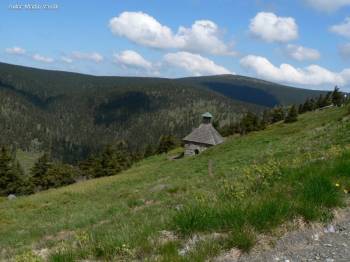Vřesová studánkaVřesová spring is a spring on the southern slope of Červené mountain on the main ridge of the Jeseníky at an altitude of 1290 m above sea level That is a very interesting place for beautiful views of the north decomposing Keprník and near the top Vozky and Spálený vrch. Reputation associated with a spring Spring is associated with the legend of the miraculous healing waters. According to her, long ago the local ranger shot and injured forester deer, but he got up the mountain Vřesová studánka and he quickly healed with the miraculous water from the well. Ranger, who saw himself suffered from an eye ailment, tested the effectiveness of the spring on him and soon his vision returned in full force. Out of gratitude, and to commemorate this miracle, he then hung up holy image neer the spring. Rumor about the spring quickly spread, and soon people began to come to the place from distant areas for miraculous water. Gradually, established small pilgrimage site near the well, which boasts that it is the highest in Moravia and Silesia! Construction on the site of the well In the 2nd half of the 17th century at the the well Vřesová was built a chapel, but it burned down after a lightning strike. From 1844 to 1850, next to the spring, local people build a church, which was twice restored. In 1946, however, the church burned down by lightning and was never rebuilt. On its foundation was erected at least a small cross. Fountain itself then in 1927 underwent enclosure in the form of a stone chapel, which still stands. Above Vřesova Studánkou amounting to 1313 m above sea level was also built in 1892 under the name Hedelbrünnel cottage Vřesová spring. After World War II it was still in operation, but was only minimally maintained, although it was very popular with tourists. 1981 was as dilapidated closed, and in 1988 demolished without compensation. Landslide in 1921 Slope below Vřesova studánka was not stable and was due to drastic mountain weather conditions in the past suffered with strong erosion. The greatest catastrophe undergone place after violent cloudburst at evening on 1 June 1921. On this day, within 30 minutes reportedly slid to 60,000 cubic meters of land with forest to river Hučivá Desna. The landslide affected area with a length of 800 m and a width up to 180 m! That day was between Keprník and Červenohorské saddle recorded the most intense torrential downpour for meteorological observation. On Červenohorské saddle rained in two hours about 180 mm of rainfall. On the mountain ridge there had naturally rained more. Soil, rocks, trees and other material from the landslide then completely cut off Hučivá Desna River valley and created a large dam. Subsequent breaking new unstable dam has caused catastrophic damage throughout the valley of the river Desna. During the subsequent disaster four people died. Source: Wikipedia | |

